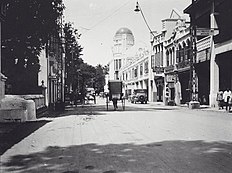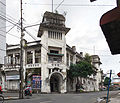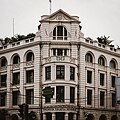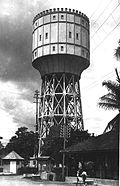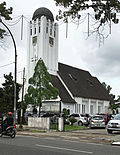
Medan is the capital and largest city of the Indonesian province of North Sumatra, as well as a regional hub and financial centre of Sumatra. According to the National Development Planning Agency, Medan is one of the four main central cities in Indonesia, alongside Jakarta, Surabaya, and Makassar. As of the 2020 Census, Medan has a population of 2,435,252 within its city limits, the official estimate as at mid 2022 was 2,494,512 and it had over 3.4 million in its built-up urban area, making it the fourth largest urban area in Indonesia. The Medan metropolitan area—which includes neighbouring Binjai, Deli Serdang Regency, and a part of Karo Regency—is the largest metropolitan area outside of Java, with 4,744,323 residents counted in the 2020 Census. Medan is a multicultural metropolis and a busy trading city bordered by the Strait of Malacca, making it one of the major economic cities in Indonesia. A gateway to the western part of Indonesia, Medan is supported by the Port of Belawan and Kualanamu International Airport. Both are connected to the city centre via toll roads and railways.
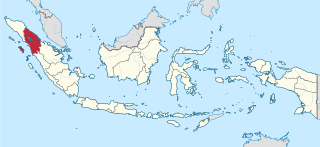
North Sumatra is a province of Indonesia located on the northern part of the island of Sumatra. Its capital and largest city is Medan. It is bordered by Aceh on the northwest and Riau and West Sumatra in the southeast, with two different coastlines located on the Indian Ocean and the Strait of Malacca, and a maritime border with Malaysia to the east. The province also shares a very narrow maritime border with Thailand to the northeast. North Sumatra is Indonesia's fourth most populous province after West Java, East Java and Central Java, and the third-largest province on the island of Sumatra after the neighbouring Riau and South Sumatra. It covers an area of 72,981 km2. According to the 2020 census, the province's population in that year was 14,799,361. The mid-2022 official estimate is 15,115,206.

Maimoon Palace or Maimun Palace is an istana of the Sultanate of Deli and a well-known landmark in Medan, the capital city of Northern Sumatra, Indonesia. Today, it serves as a museum. The name is the Arabic word for "blessing".

Medan Station (MDN) is the main railway station in Medan, North Sumatra, Indonesia. In addition to intercity services operated by Indonesia's national rail operator, Kereta Api Indonesia, the station also has service to Kualanamu International Airport via Kualanamu ARS.

Tjong A Fie, Majoor der Chinezen (1860–1921), or Tjong Yiauw Hian, birth name Zhang Hongnan, was a Hakka Chinese businessman, banker and kapitan who built a large plantation business in Sumatra, Indonesia. Tjong A Fie built his business that employed more than 10,000 labor workers. Because of his great success, he maintained a good relationship with the ruler of Deli, including the ninth Sultan of Deli, Sultan Ma'mun Al Rashid Perkasa Alamyah and Dutch authorities.
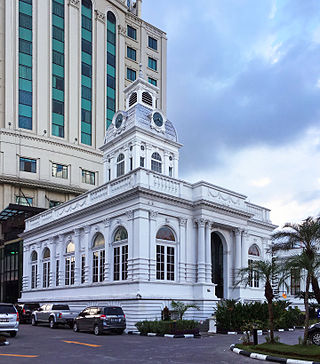
Old Medan City Hall is a building located on Jalan Balai Kota, Medan, North Sumatra.

A landhuis is a Dutch colonial country house, often the administrative heart of a particuliere land or private domain in the Dutch East Indies, now Indonesia. Many country houses were built by the Dutch in other colonial settlements, such as Galle, Cape Town and Curaçao, but none as extensively or elaborately as in the Residency of Batavia. Much of Batavia's reputation as "Queen of the East" rested on the grandeur of these 18th-century mansions.

The colonial architecture of Indonesia refers to the buildings that were created across Indonesia during the Dutch colonial period, during that time, this region was known as the Dutch East Indies. These types of colonial era structures are more prevalent in Java and Sumatra, as those islands were considered more economically significant during the Dutch imperial period. As a result of this, there is a large number of well preserved colonial era buildings that are still densely concentrated within Indonesian cities in Java and Sumatra to this day.
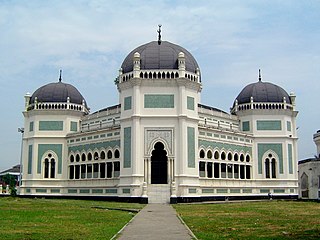
Grand Mosque of Medan or Masjid Raya Al-Mashun is a mosque located in Medan, Indonesia. The mosque was built in the year 1906 and completed in 1909. In beginning of its establishment, the mosque was a part of the Maimun palace complex. Its architectural style combines Middle Eastern, Indian and Spanish elements. The mosque has an octagonal shape and has wings to the south, east, north and west.

New Indies Style is a modern architectural style used in the Dutch East Indies between the late 19th century through pre-World War II 20th century. New Indies Style is basically early modern (western) architecture, which applies local architectural elements such as wide eaves or prominent roof as an attempt to conform with the tropical climate of Indonesia.

Kesawan is a district (kelurahan) in West Medan, Medan, Indonesia. This region is filled with historic buildings along Jalan Ahmad Yani, the oldest street in Medan.

Charles J. Kleingrothe, born Carl Josef Kleingrothe or Klein-Grothe, known as C. J. Kleingrothe was a German photographer who since 1889 (?) had a studio in Medan, Sumatra at the end of the 19th century and early 20th century. In 1891 (?) he partnered with the Swedish photographer H. Stafhell for ten years and photographed the landscapes and architecture as well as portraits. In 1901, the partnership ended and in 1902 Kleingrothe opened a studio on Kesawan street in downtown Medan and photographed agricultural subjects including tobacco, coffee, tea, rubber and palm oil cultivation, administration and transport, portraits and nudes.

NV Hotel Mijn de Boer is a Dutch colonial style hotel located on the Cremerweg, Medan, Dutch East Indies, current-day Indonesia. The hotel was built in 1898 by Workum native and Dutch businessman Aeint Herman de Boer.

Al-Osmani Mosque is a mosque in Medan, North Sumatra, Indonesia. The mosque is also known as Labuhan mosque because of its location in the district of Medan Labuhan. The mosque is located on the K.L. Yos Sudarso road, subdistrict of Pekan Labuhan, about 20 kilometers north of the city of Medan. In front of this mosque there are a school, named YASPI School and not far from the mosque there are a Chinese temple named Pekong Lima and in front of the temple there is a path that leads to Labuhan market. The mosque is the oldest in the city of Medan.

Johannes Martinus (Han) Groenewegen was a Dutch architect who was active in the Netherlands and the Dutch East Indies, and subsequently, Indonesia from the 1920s to the 1960s.
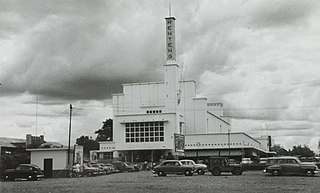
Menteng Cinema was a cinema in Jakarta, Indonesia. The cinema was designed by Dutch architect J.M. Groenewegen in 1949, one of the architect who was active in Indonesia before and after the World War II. Menteng Cinema is Groenewegen's first cinema project, which would give birth to several other cinemas in Indonesia which has the same architectural style of Nieuwe Bouwen. Menteng Cinema was demolished in 1988, standing above the site now is the Menteng Huis shopping complex.

Tjong Yong Hian (1850–1911) was a Hakka Chinese businessman and kapitan who had a great contribution to the development of society in the city of Medan around the early 1900s, he is also brother of Tjong A Fie, the successor kapitan after him.
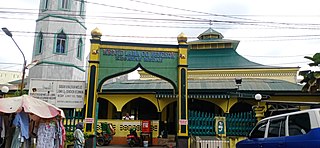
Gang Bengkok Old Mosque, is a mosque located in Medan, North Sumatra, Indonesia. The Gang Bengkok Old Mosque is precisely located on Jalan Mesjid, Kesawan, West Medan Districy, Medan. Gang Bengkok Old Mosque was built by a merchant and Kapitan from Guangdong, China, named Tjong A Fie. This mosque was first built in 1885, but the renovation was completed in 1889. This mosque was then handed over by Tjong A Fie to the Deli Sultanate, namely during the reign of Sultan Deli Sultan Ma'mun Al Rashid.

